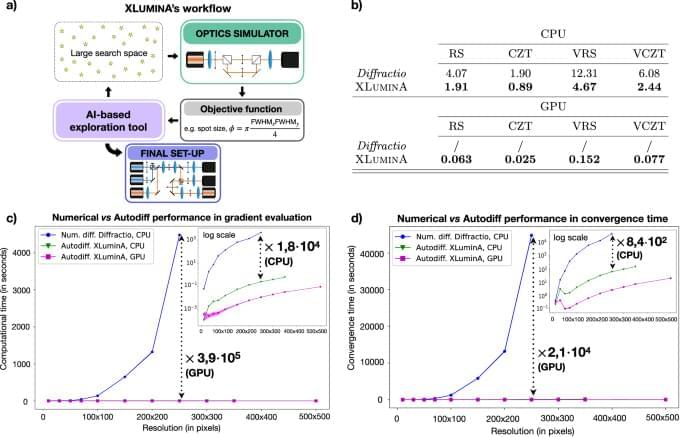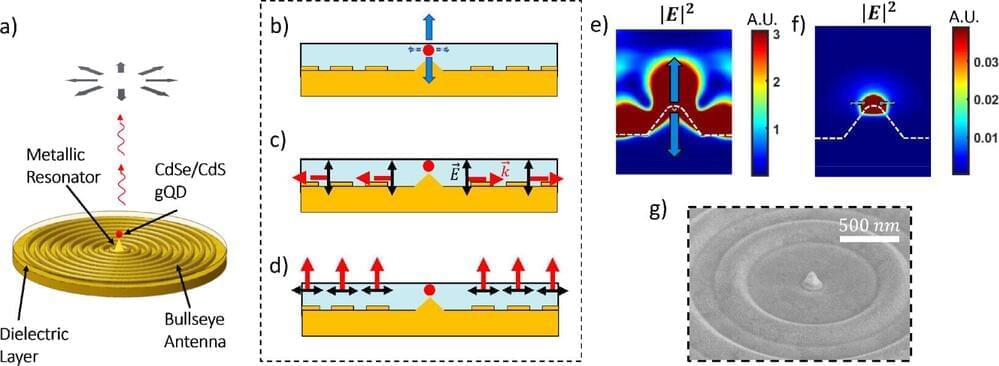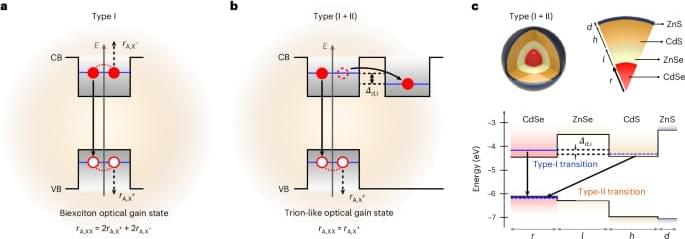Researchers have developed XLuminA, an AI framework for the automated discovery of super-resolution microscopy techniques. With 10,000x faster optimization than traditional methods, it discovers unexplored designs breaking the diffraction limit.
Researchers have developed a tiny, room-temperature device that creates a special type of structured light called radially polarized photons, which are highly useful for secure communication, advanced imaging, and precision optical tools.
By carefully designing and positioning a quantum dot within a nanoantenna, they achieved high-quality light with more than 93% polarization purity. This breakthrough helps improve the efficiency and practicality of devices that use structured light, paving the way for advancements in communication and optical technology.
A team led by Prof. Ronen Rapaport from the Racah School of Physics at The Hebrew University of Jerusalem has developed the new device that produces radially polarized photons at room temperature. This advancement offers new possibilities for both classical and quantum communication technologies.
New analysis supports Einstein’s relativity and narrows neutrino mass ranges, hinting at evolving dark energy.
Gravity, the fundamental force sculpting the universe, has shaped tiny variations in matter from the early cosmos into the vast networks of galaxies we see today. Using data from the Dark Energy Spectroscopic Instrument (DESI), scientists have traced the evolution of these cosmic structures over the past 11 billion years. This research represents the most precise large-scale test of gravity ever conducted, offering unprecedented insights into the universe’s formation and behavior.
Introduction to DESI and its global impact.
Critical Cleo software flaw exploited en masse; update Harmony, VLTrader, LexiCom to prevent ransomware attacks.
Updated Antidot banking trojan targets Android users via fake job offers, stealing credentials and taking remote control.
Phishing gang arrested in Belgium and Netherlands; Europol seizes luxury goods, cash, and millions stolen.
A vulnerability in WPForms, a WordPress plugin used in over 6 million websites, could allow subscriber-level users to issue arbitrary Stripe refunds or cancel subscriptions.
Tracked under CVE-2024–11205, the flaw was categorized as a high-severity problem due to the authentication prerequisite. However, given that membership systems are available on most sites, exploitation may be fairly easy in most cases.
The issue impacts WPForms from version 1.8.4 and up to 1.9.2.1, with a patch pushed in version 1.9.2.2, released last month.
Microsoft has now partially lifted a compatibility hold blocking the Windows 24H2 update on systems with some Ubisoft games after the French video game publisher has fixed bugs causing crashes, freezes, and audio issues.
The company blocked Windows 24H2 upgrades on PCs with Assassin’s Creed, Star Wars Outlaws, and Avatar: Frontiers of Pandora games more than two weeks ago, following a stream of user reports on Reddit [1, 2] and the Microsoft Answers forums [1, 2, 3] that these games were no longer working correctly.
Windows users affected by this known issue were particularly frustrated as they reported these issues in the Windows Insider Feedback Hub, on Reddit, and other online platforms since Windows 11 24H2 was still in preview.
Present-day liquid-state lasers are based on organic dyes. Here we demonstrate an alternative class of liquid lasers that use solutions of colloidal quantum dots (QDs). Previous efforts to realize such devices have been hampered by the fast non-radiative Auger recombination of multicarrier states required for optical gain. Here we overcome this challenge by using type-(I + II) QDs, which feature a trion-like optical gain state with strongly suppressed Auger recombination. When combined with a Littrow optical cavity, static (non-circulated) solutions of these QDs exhibit stable lasing tunable from 634 nm to 575 nm. These results indicate the feasibility of technologically viable dye-like QD lasers that exhibit broad spectral tunability and, importantly, provide stable operation without the need for a circulation system—a standard attribute of traditional dye lasers. The latter opens the door to less complex and more compact devices that can be readily integrated with various optical and electro-optical systems. An additional advantage of these lasers is the wide range of potentially available wavelengths that can be selected by controlling the composition, size and structure of the QDs.
Liquid lasers based on solutions of colloidal quantum dots exhibit a trion-like optical gain state with suppressed Auger recombination, which combined with a Littrow optical cavity enables stable and tunable liquid-state lasing.
Researchers at Lawrence Livermore National Laboratory (LLNL) have developed a new approach that combines generative artificial intelligence (AI) and first-principles simulations to predict three-dimensional (3D) atomic structures of highly complex materials.
This research highlights LLNL’s efforts in advancing machine learning for materials science research and supporting the Lab’s mission to develop innovative technological solutions for energy and sustainability.
The study, recently published in Machine Learning: Science and Technology, represents a potential leap forward in the application of AI for materials characterization and inverse design.









